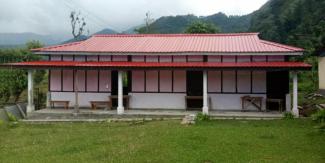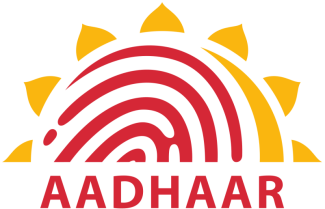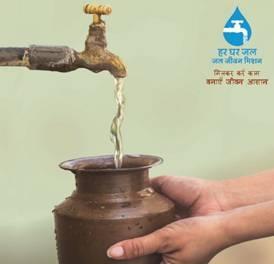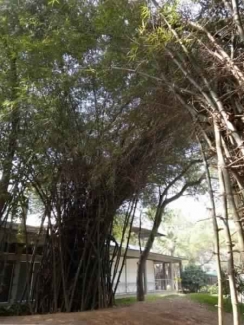
इस समाचार को हिन्दी में पढ़े आगे...
To monitor the rural drinking water supply systems in villages, the Ministry of Jal Shakti has decided to take the digital route to usesensor-based IoT devices to effectively monitor the implementation of Jal Jeevan Mission (JJM) in more than six lakh villages. For this, National Jal Jeevan Mission in collaboration with Tata Community Initiatives Trust (TCIT) and Tata Trusts recently completed pilot projects in several remote villages of five States i.e. Uttarakhand, Rajasthan, Gujarat, Maharashtra, and Himachal Pradesh. A key feature of these pilots has been the use of frugal yet sturdy sensors, which makes the solution scalable and sustainable. One of the key challenges posed to the team was to develop a robust solution at a fraction of the water infrastructure costs (<10-15% of total scheme capex) without compromising on quality or functionality. These costs are expected to reduce further at scale. More importantly, majority of the vendors, including manufacturers, are Indian players, thereby giving a boost to Government’s AatmaNirbhar Bharat programme. The pilots went live in September 2020 despite challenges during CoVid-19 pandemic.
The Internet of Things (IoT) based remote monitoring provides near real-time information without any manual intervention by using sensors. This would not only allow effective monitoring and management on-ground, but also enable real-time visibility to State water supply/ PHED officials, and citizens. With a futuristic vision to ensure regular tap water to every home, real-time measurement and monitoring is critical for rural drinking water supply schemes, with enormous gains in terms of operational efficiencies, cost reduction, grievance redressal, etc. Data will drive improvement in service delivery and instill transparency for precious natural asset such as water. Thus, making a strong social and economic case for deployment of such a system.
Rural drinking water supply design varies considerably across different regions of the country. These pilots were spread across diverse agro-climatic conditions - including areas in western Himalayas, desert regions to Gangetic plains (spanning extreme cold of -100C to severe heat of 480C. These pilots cover different types of sources such as groundwater based borewells, springs in hilly areas, and surface water (river and dams) and villages with a population of a few hundreds to several thousands. The pilots also demonstrated a first-of-its-kind comprehensive (source to tap) remote monitoring and control system in a completely off-grid (using solar and battery only) rural environment in Sirohi district, Rajasthan.
Several types of sensors have been deployed including flow meters, ground water level sensors, chlorine analyzers, pressure sensors, pump controller etc. to measure all the relevant aspects of water service delivery – quantity, duration, quality, pressure, and sustainability – in addition to providing operational efficiencies. The cloud and analytics powered IoT Platform is integrated with a GIS (Geographical Information System) providing a robust decision support system.
The pilots have led to several outcomes as it has helped identify distribution issues – such as outages, leakages, low pressure, etc. and led to resolution across sites. It recently alerted both officials and community regarding fast depleting groundwater levels, that led the villagers to build a source strengthening structure to recharge their borewell. Other benefits observed include efficient and responsible use of water by community and reduced cost of operations through data-enabled leak detection, predictive maintenance, and automation.
Drinking water supply systems in Indian villages face multiple challenges of drying up of groundwater source, pump failures, irregular and inadequate water supply, etc. These challenges invariably aggravate socio-economic disparities, like women transporting water, often on foot over several kilometers; several water-borne diseases, which could easily be avoided; also, economic – wage loss and expenditure on medical care. The need of the hour is to ensure and put in place systems to effectively monitor and manage rural water supply.
Jal Jeevan Mission (JJM), Union Government's flagship programme, which is implemented in partnership with States/ UTs to provide tap water connection to every rural household by 2024 envisions creating a Digital Wall and Remote Command & Control Centre for monitoring and managing supply of prescribed quality water in adequate quantity (55 Liters Per Capita per Day - LPCD) every day through household tap connections across all rural villages.
जल जीवन मिशन ने ग्रामीण पेयजल आपूर्ति प्रणाली की निगरानी के लिए अपनी तरह के पहलेसेंसर आधारित इंटरनेट ऑफ थिंग्स (आईओटी) उपकरण लगाए
गांवों में ग्रामीण पेयजल आपूर्ति प्रणाली की निगरानी के लिए, जल शक्ति मंत्रालय ने डिजिटल मार्ग अपनाने का निर्णय लिया है। छह लाख से अधिक गांवों में जल जीवन मिशन के कार्यान्वन की प्रभावी निगरानी के लिए सेंसर आधारित आईओटी उपकरण का इस्तेमाल करने का फैसला लिया गया है। इसके लिए राष्ट्रीय जल जीवन मिशन ने टाटा कम्यूनिटी इनिशिएटिव ट्रस्ट (टीसीआईटी) और टाटा ट्रस्ट्स के साथ मिलकर पांच राज्यों उत्तराखंड, राजस्थान, गुजरात, महाराष्ट्र और हिमाचल प्रदेश के दूरदराज स्थित कई गांवों में पायलट प्रोजेक्ट्स पूरे किए। इन पायलट प्रोजेक्ट्स की खास विशेषता किफायती मगर मजबूत सेंसर है जो समाधान को मापनीय और टिकाऊ बनाता है। टीम के सामने प्रस्तुत प्रमुख चुनौतियों में से एक, गुणवत्ता या काम से समझौता किए बिना पानी के बुनियादी ढांचे की लागत के छोटे से हिस्से (योजना के कुल पूंजीगत व्यय का <10-15%) पर मजबूत समाधान का विकास करना था। एक स्तर पर इसलागत के और भी कम होने की उम्मीद है। सबसे महत्वपूर्ण बात यह है कि इसके निर्माताओं समेत ज्यादातर विक्रेता भारतीय हैं जिससे कि सरकार के आत्मनिर्भर भारत कार्यक्रम को बढ़ावा मिलता है। यह पायलट प्रोजेक्ट कोविड-19 की चुनौतियों के बावजूदसितंबर 2020 में शुरू हुए थे।
इंटरनेट ऑफ थिंग्स (आईओटी) पर आधारित रिमोट मॉनिटरिंग,सेंसर का उपयोग करके बिना किसी मानवीय हस्तक्षेप के लगभग वास्तविक जानकारी उपलब्ध करवाती है। इससे ना सिर्फ जमीनी स्तर पर प्रभावी निगरानी और प्रबंधन होता है बल्कियह राज्य जलापूर्ति/पीएचईडी अधिकारियों और नागरिकों को भी वास्तविक समय की दृश्यता के लिए सक्षम बनाती है।प्रत्येक घर के लिए नल के पानी की नियमित आपूर्ति के दृष्टिकोण के साथ, ग्रामीण पेयजल की आपूर्ति योजना के लिए, परिचालन क्षमताओं में सुधार, लागत में कमी, शिकायत निवारण आदि के साथ, वास्तविक माप और निगरानी भी महत्वपूर्ण है। आंकड़ेसेवा उपलब्ध कराने और पानी जैसे अमूल्य प्राकृतिक संसाधन के लिएपारदर्शिता लाने में सुधार करेंगे। अतः इस प्रकार की प्रणाली की तैनाती के लिए मजबूत सामाजिक और आर्थिक वातावरण बनाया जा रहा है।
ग्रामीण पेयजल आपूर्ति डिजाइन देश के अलग क्षेत्रों में भिन्न-भिन्न है। अतः यह पायलट प्रोजेक्ट्स भी विभिन्न कृषि-जलवायु परिस्थितियों में फैले हुए थे जिनमें पश्चिमी हिमालय, रेगिस्तानी क्षेत्र से लेकर गंगा के मैदान (-100 डिग्री सेल्सियस की कड़ी ठंड से लेकर 480 डिग्री सेल्सियस की भीषण गर्मी तक प्रसारित) शामिल हैं। इन पायलट प्रोजेक्ट्स में विभिन्न प्रकार के स्रोतों को शामिलकिया गया है जैसे कि बोरवेल से भूजल, पहाड़ी क्षेत्रों में स्प्रिन्ग्स और सतही जल (नदी और बांध) और कुछ सौ से लेकर हजारों तक की आबादी वाले गांव। पायलट प्रोजेक्ट्स के तहत, राजस्थान के सिरोही जिले में पूरी तरह से ऑफ ग्रिड (सिर्फ सौर और बैटरी का इस्तेमाल करके) ग्रामीण वातावरण मेंअपनी तरह के पहले व्यापक (स्रोत से नल) रिमोट मॉनिटरिंग और नियंत्रण प्रणाली का प्रदर्शन किया गया।
परिचालन क्षमता प्रदान करने के साथ जल सेवा वितरण के विभिन्न प्रासंगिक पहलुओं जैसे कि मात्रा, अवधि, गुणवत्ता, दबाव और स्थिरता मापने के लिएकई प्रकार के सेंसर लगाए गए हैंजैसे कि फ्लो मीटर्स, भूजल स्तरीय सेंसर, क्लोरीन विश्लेषक, प्रेशर सेंसर, पम्प कंट्रोलर आदि।क्लाउड और एनालिटिक्स से प्रेरित आईओटी प्लेटफॉर्म जीआईएस (भौगोलिक सूचना प्रणाली) से जुड़ा हुआ है जो मजबूत डिसीजन सपोर्ट प्रणाली प्रदान करता है।
इन पायलट्स से कई परिणाम निकले क्योंकि इससे कटौती, लीकेज, कम दबाव जैसे वितरण के मुद्दों को पहचानने और कार्यस्थल पर समाधान निकालनेमें मदद मिली। इसने हाल ही में तेजी से घटते भूजल स्तर के बारे में अधिकारियों और समुदाय दोनों को चेताया जिससे कि ग्रामीणों ने अपने बोरवेल के पुनर्भरण के लिए स्रोत को मजबूत करने वाला ढांचा बनाया।इन पायलट्स के अन्य लाभों में समुदाय द्वारा पानी के कुशल और जिम्मेदारी भरे उपयोग, डेटा-अनेबल लीक डिटेक्शन के माध्यम से परिचालन लागत में कमी और भविष्यसूचक रखरखाव व स्वचालन शामिल हैं।
गांव में स्थानीय भाषा में विजुअल डैशबोर्ड वाले छोटी टीवी स्क्रीन हैं जिससे वीडब्ल्यूएससी/पानी समिति को सही कदम उठाने में मदद मिलती है। इससे सकारात्मक व्यवहार परिवर्तन में मदद मिली है। पहले, इनमें से कुछ गांवों में नियमित रूप से पानी की कीटाणुशोधन प्रक्रिया नहीं की जाती थी। अब वीडब्ल्यूएससी (पानी समिति) अपने गांव की आईओटी स्क्रीन पर विजुअल इंडिकेटर के माध्यम से देखते हैं कि अवशिष्ट क्लोरीन के स्तर के आधार पर कब पानी का कीटाणुशोधन करना है।
भारतीय गांवों में पेयजल आपूर्ति प्रणाली, भूजल स्रोत के सूखने, पम्प की विफलता, अनियमितता और अपर्याप्त जल आपूर्ति जैसी कई चुनौतियों का सामना कर रही है। यह चुनौतियां सामाजिक-आर्थिक असमानताओं को बढ़ावा देती हैं जैसे कि महिलाओं का कुछ दूरी से लेकर कई किलोमीटर तक की दूरी से पानी लाना, कई जल जनित बीमारियां जिनसे आसानी से बचा जा सकता है, आर्थिक-मजदूरी का नुकसान और चिकित्सा पर खर्च। ग्रामीण जल आपूर्ति का प्रबंधन और प्रभावी निगरानी के लिए एक प्रणाली की स्थापना करना समय की आवश्यकता है।
2024 तक प्रत्येक ग्रामीण घर में नल के पानी का कनेक्शन प्रदान करने के लिए केंद्रीय सरकार का फ्लैगशिप कार्यक्रम जल जीवन मिशन (जेजेएम), जिसे राज्यों/केंद्र शासित प्रदेशों के साथ साझा तौर पर लागू करना है, वह सभी ग्रामीण क्षेत्रों केघरों में नल के कनेक्शन के जरिए प्रतिदिन गुणवत्तापूर्णपानी की पर्याप्त मात्रा (55 लीटर प्रति व्यक्ति प्रति दिन-एलपीसीडी) की आपूर्ति के प्रबंधन और निगरानी के लिए डिजिटल वॉल और रिमोट कमांड व नियंत्रण केंद्र स्थापित करने की कल्पना करता है।











